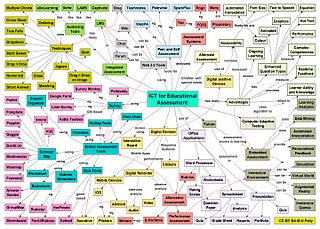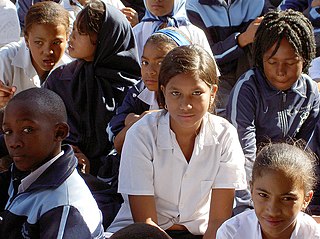The digital divide is the unequal access to digital technology, including smartphones, tablets, laptops, and the internet. The digital divide creates a division and inequality around access to information and resources. In the Information Age in which information and communication technologies (ICTs) have eclipsed manufacturing technologies as the basis for world economies and social connectivity, people without access to the Internet and other ICTs are at a socio-economic disadvantage, for they are unable or less able to find and apply for jobs, shop and learn.
The global digital divide describes global disparities, primarily between developed and developing countries, in regards to access to computing and information resources such as the Internet and the opportunities derived from such access.

Information and communications technology (ICT) is an extensional term for information technology (IT) that stresses the role of unified communications and the integration of telecommunications and computers, as well as necessary enterprise software, middleware, storage and audiovisual, that enable users to access, store, transmit, understand and manipulate information.

Education in South Africa is governed by two national departments, namely the Department of Basic Education (DBE), which is responsible for primary and secondary schools, and the Department of Higher Education and Training (DHET), which is responsible for tertiary education and vocational training. Prior to 2009, both departments were represented in a single Department of Education. Among sub-Saharan African countries, South Africa has one of the highest literacy rates. According to The World Factbook - Central Intelligence Agency as of 2019, 95% of the population age 15 and over can read and write in South Africa were respectively literate.
Digital literacy is an individual's ability to find, evaluate, and communicate information using typing or digital media platforms. It is a combination of both technical and cognitive abilities in using information and communication technologies to create, evaluate, and share information.
The knowledge divide is the gap between those who can find, create, manage, process, and disseminate information or knowledge, and those who are impaired in this process. According to a 2005 UNESCO World Report, the rise in the 21st century of a global information society has resulted in the emergence of knowledge as a valuable resource, increasingly determining who has access to power and profit. The rapid dissemination of information on a potentially global scale as a result of new information media and the globally uneven ability to assimilate knowledge and information has resulted in potentially expanding gaps in knowledge between individuals and nations. The digital divide is an extension of the knowledge divide, dividing people who have access to the internet and those who do not. The knowledge divide also represents the inequalities of knowledge among different identities, including but not limited to race, economic status, and gender.

Transliteracy is "a fluidity of movement across a range of technologies, media and contexts". It is an ability to use diverse techniques to collaborate across different social groups.

Information and media literacy (IML) enables people to show and make informed judgments as users of information and media, as well as to become skillful creators and producers of information and media messages. IML is a combination of information literacy and media literacy. The transformative nature of IML includes creative works and creating new knowledge; to publish and collaborate responsibly requires ethical, cultural and social understanding.
Over the past decade, there has been an increase in the use of information and communications technologies (ICTs) in China. As the largest developing country in the world, China faces a severe digital divide, which exists not only between mainland China and the developed countries, but also among its own regions and social groups.
Computer technology for developing areas is a field focused on using technology to improve the quality of life and support economic development in regions with limited access to resources and infrastructure. This area of research seeks to address the digital divide, which refers to the gap between those who have access to technology and those who do not, and the resulting inequalities in education, healthcare, and economic opportunities.
The digital divide in the United States refers to inequalities between individuals, households, and other groups of different demographic and socioeconomic levels in access to information and communication technologies ("ICTs") and in the knowledge and skills needed to effectively use the information gained from connecting.
The digital divide is described as the characterization of the gap between individuals or countries that have access to technology and individuals or countries that do not. This also includes, but is not limited to: access to computers, internet, and information literacy. General contributions to the digital divide are geography and next generational users. Next generational users are more involved with using devices that can connect to the internet, while the geography factor focuses more on how an individual's location put them at an advantage or disadvantage to compete with the digital age. However, only a handful on people and communities are being represented. Underdeveloped geographical locations, like certain regions of the continent of Africa serves as one of the underrepresented minorities. In particular, South Africa faces many developmental problems that make it one of the more complex societies in the world to map the digital divide in. The country is divided by ethnic inequality and discrepancies in the level of development between different sectors. These obstacles result in disparities in access to information and communications technology (ICT). This disparity is commonly known as the digital divide. There has been another major contributor, namely, Telkom and its monopolistic hold on the progress of ICT in South Africa. South Africa faces unique challenges in addressing the digital divide, including ethnic inequality, disparities in development levels between different sectors, and a historically monopolistic telecommunications industry. Efforts to bridge the digital divide in South Africa involve a combination of government initiatives, non-governmental organizations (NGOs), non-profit organizations (NPOs), and public-private partnerships, all working towards increasing access to technology, promoting digital literacy, and enhancing digital skills among the population.
Educational technology in sub-Saharan Africa refers to the promotion, development and use of information and communication technologies (ICT), m-learning, media, and other technological tools to improve aspects of education in sub-Saharan Africa. Since the 1960s, various information and communication technologies have aroused strong interest in sub-Saharan Africa as a way of increasing access to education, and enhancing its quality and fairness.

The digital divide in Germany, the second most populous state and leading economic powerhouse in Europe, refers to the ever-growing gap between members of society without computer or Internet access and those with access. There are several factors contributing to the digital divide in Germany, including age, gender, family structure, education, ethnicity, and motivation. With a large market of Information and Communications Technology (ICT) in Germany, there are still areas that don't have access to high-speed internet. Internet access in Germany is more available in big cities compared to rural communities. The German government has taken initiative to increase internet access through the rural communities by adding free internet access throughout the communities, as well as, increase internet education in schools.
The digital divide in Malaysia refers to the gap between people who have access to certain technologies within the country of Malaysia. The presence of the digital divide is due to several factors that include age, location, and wealth, all of which can contribute to the gap in availability of information communication technology (ICT). Malaysia is not a fully developed country, which has led some researchers to express concern that the limited access to ICT may cause the country to fall even further behind in the progress of worldwide technology if this issue is not addressed and mended.

The digital divide is an economic and social inequality with regard to access to, use of, or impact of information and communication technologies (ICT). Factors causing the divide can vary depending on the country and culture, as can the potential solutions for minimizing or closing the divide.

The digital divide in Thailand refers to the economic, educational, and social inequalities between the Thai people who have access to information and communications technology (ICT) and those who do not. Thailand is a developing country within Southeast Asia, and is currently confronted with this problem. There are a number of factors that determine the digital divide within a country, including income, choice of technologies and socioeconomic factors. ICT development and mobile penetration are strongly correlated with economic growth and social benefits.
The digital divide in France refers to inequalities between individuals, households, and other groups of different demographic and socioeconomic levels in France in access to information and communication technologies ("ICTs") and in the knowledge and skills needed to effectively use the information gained from connecting.
Digital inclusion involves the activities necessary to ensure equitable access to and use of information and communication technologies for participation in social and economic life including for education, social services, health, social and community participation. Digital inclusion includes access to affordable broadband Internet services, Internet-enabled devices, access to digital literacy training, quality technical support, and applications and online content designed to enable and encourage self-sufficiency, participation, and collaboration. Related concepts include digital divide, digital exclusion and digital inequality however digital inclusion focuses more on the strategies, policies and programs required to address the digital divide.
Gender digital divide is defined as gender biases coded into technology products, technology sector and digital skills education.








